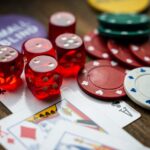he objective of the player who plays blackjack is to get an accumulated total equivalent to 21. If ever 21 were not garnered, the player or the dealer with cards total closer to 21 would be the winner. Players avoid having a total of more than 21 because it automatically disqualify the player for that particular set or diminishes the player’s chance of defeating the dealer. Unless of course the dealer’s card is over 21 also, the player and the dealer have a tie; no one wins or in blackjack term “push or stand-off”. Cards with faces such as Jacks, Queens and Kings plus the number 10 card have the values worth 10 counts while the Aces have the value equivalent to 1 or 11 counts whichever is necessary. Other cards such as 2 to 10 have the value whatever the card is. A blackjack is a combination of an ace and a card with a value of 10. Dealing a blackjack makes the player an automatic winner and be rewarded 1.5 times his bet unless the dealer ties with the player. If a player feels that his cards’ total is closer to 21 than the dealer, he could always stand whenever he fells necessary.
The Blackjack Table
The table of the game blackjack consists of about six players with either six to eight decks of cards are to be used during the game.
… And the Blackjack Sequence
At the start of the game, the dealer would need to shuffle the cards and would place this shuffled cards in a box dispenser called “shoe”.
The casino dealer would then distribute each player two cards facing down but before that, the player would need to place a bet first.
The dealer also place two cards for himself, one facing down and the other facing up. After viewing their cards, the player would either stand or request another card (HIT) whatever they feel is necessary.
If the player feels that his cards total is enough to beat the dealer, he would stand, but if he feels that he needs to add some more to his cards, he would probably request for another card (HIT).
Player must see to it that the total of his cards would not exceed 21 to be able to garner a chance to beat the dealer.
The casino players with cards that do not exceed 21 would wait for the turn of the dealer.
And after all the players have decided what the next move is, the dealer would need to show his card that is turned down.
If the dealer’s count is 17 and up, he would need to stay by the rule but if his cards total is 16 and less, he would need to draw.
If the player got his first two cards with a total of 21, it is called blackjack, like for example, an ace and a 10 or one of the faces cards such as jack, queen or king, the player wins automatically and be rewarded one and one-half times his bet.
But if the player and the dealer both got blackjack, it is called a push, a tie or a standoff and the player would get his bet back.
The other players who got a cards’ total of closer to 21 than the dealer, the player wins and get an amount parallel to his stake.
On the other hand, if player’s card total is less than the card’s total of the dealer, the player loses and wastes his bet.
If the card’s total of the dealer exceeds 21, he is busted and all the other players win.
The Betting Options
There are existing choices to consider when betting. The casino player must have a good decision whenever a move is necessary. But never fail to remember that the player would just play for luck and does not include wisdom much on how knowledgeable the player in regards to the game. Moreover, making a decision while on game still involves luck as it is the only biggest factor in any players’ triumph or failure in playing blackjack. Below are the betting options that are needed to be considered in making a decision for the player’s next move.
Insurance:
This is a side bet amounting to half the price of the initial bet opposing the dealer having a probable blackjack, (21). This is only permitted when the card of the dealer that is exposed to all is an Ace. If the other card of the dealer which is facing down happens to be 10 or any face card which has the value equivalent to 10. The dealer got a blackjack card so this insurance would pay double the amount of the bet.
Surrender:
if the player feels that his cards is hopeless, the player can give up his hand and accepts that he loses half of his bet.
Early Surrender:
This can be done previous to the verification of the dealer for blackjack.
Late Surrender:
If the dealer has already verified his cards and noticed that he has blackjack, surrender will no longer be allowed.
Double Down:
Players can double his first bet on the condition that he would just hit another one card. This is actually considered as a good bet especially if the player has a good hand. This side bet is permitted by most of the casinos but some will only allow players after splitting.
Even Money:
Players can demand to reward him right away if he has a blackjack even without checking first the result of the dealer’s card. This is only allowed when the dealer’s exposed card is an ace. If the dealer allowed the player to do this, the player would be rewarded exactly the same amount of his bet instead of 1 and half times the bet.
Split Hand:
The casino players are allowed to tear the preliminary two-card hand into two and play them unconnectedly. This is only permitted when the two initial cards have the same value. These cards that are split can be used as the beginning of another unconnected hand and can put another bet which is equal to the initial bet.
Hard Hand:
If a player or a dealer has no ace or even has an ace but can only be counted as 1, this is called a hard hand.
Soft Hand:
If a player has an ace and can be counted as either 11 or 1 is called a soft hand.




